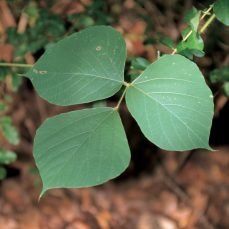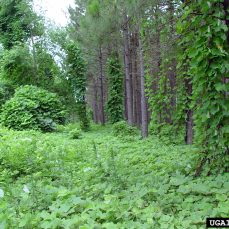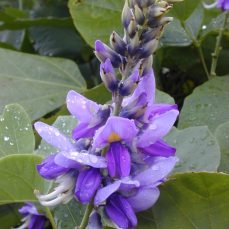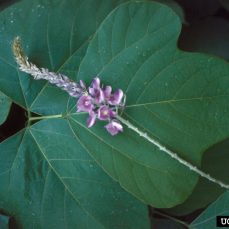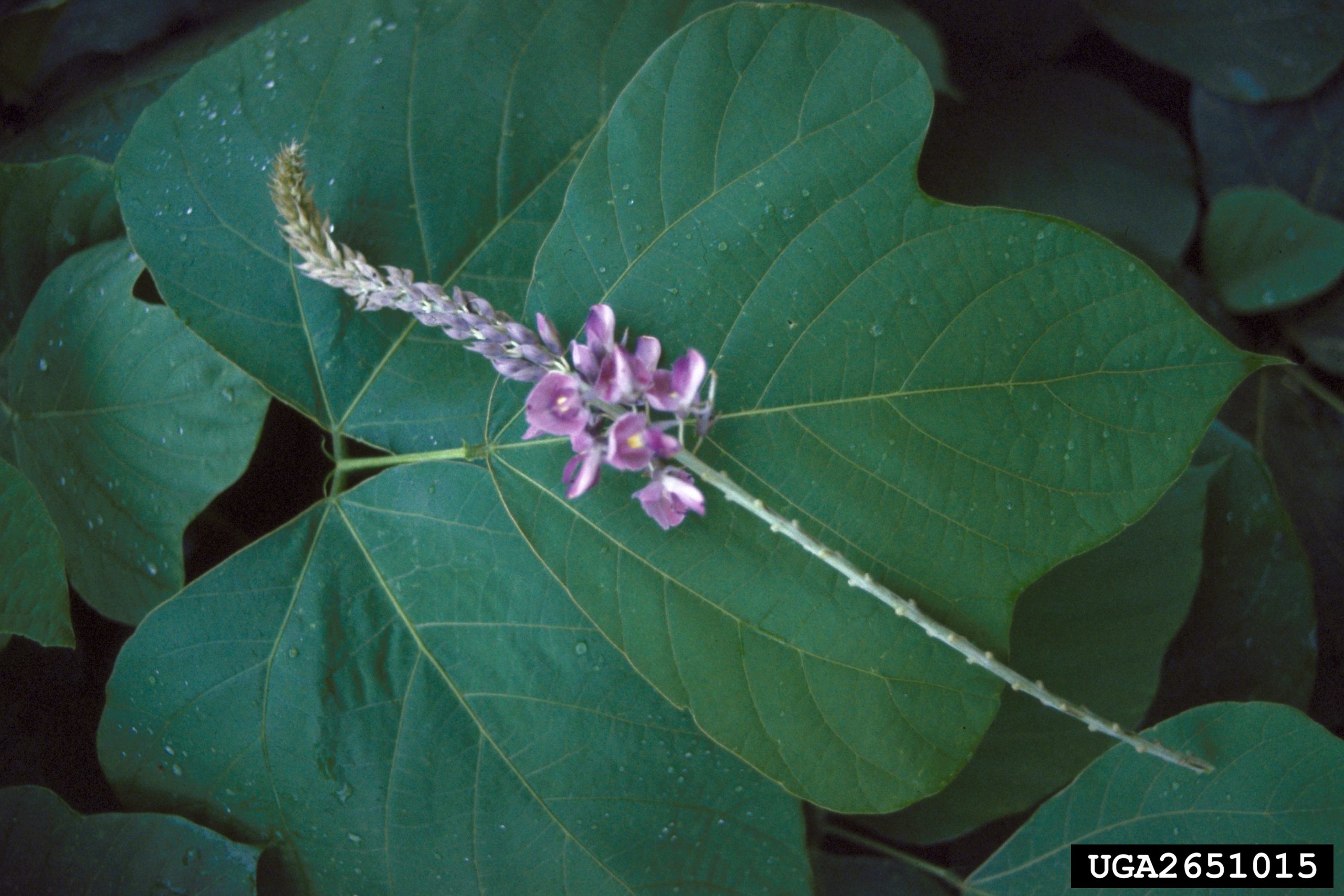
Photo credit: David J. Moorhead, University of Georgia, Bugwood.org
Management Strategy
Squamish
Whistler
Pemberton
Vectors of Spread
Synonyms
Foot-a-night vine, Ko-hemp.
ID Characteristics
General: Kudzu is a deciduous perennial climbing vine that is part of the pea family (Fabaceae). It can grow up to 10 – 30 m long.
Flowers: Pea-like, purple-pink flowers that grow in low-hanging clusters. Flowers are highly fragrant and smell like grapes.
Stem: Young stems are yellow-green, while mature stems are dark brown and woody, with white pits in the bark. Stems can grow up to 10 cm in diameter.
Leaves: Alternate, with three broad leaflets per leaf. Leaves range from 7 – 25 cm long.
Fruit: Hairy, brown, flattened pods that are 5 – 9 cm long.
Roots: Large root tubers.
Similar Species
Exotic:

Hog peanut (Steven Katovich, Bugwood.org)
Hog peanut (Amphicarpaea bracteate) only grows 1.5 meters tall and has pale violet or white flowers.

Riverbank grape (David Cappaert, Bugwood.org)
Riverbank grape (Vitis riparia) has coarsely toothed leaves with simple leaves (no leaflets).
Habitat and Origin
Originally from Eastern Asia, kudzu was first brought to North America as a garden ornamental. It was also used as livestock forage and for erosion control.
Kudzu thrives in full sun and abundant moisture. While it can survive in a wide range of conditions, it is best adapted to deep, well-drained, sandy soils on disturbed sites. Kudzu often grows in abandoned fields and urban lots, roadsides, forest edges, fields, croplands and pastures.
How it Spreads
Kudzu reproduces mainly vegetatively but also by seed. Kudzu can spread aggressively through its stem nodes and tuberous rhizomes (roots).
Short-distance spread occurs mainly through kudzu’s creeping vines. Kudzu grows very quickly – up to 30 cm per day! This plant is spread over longer distances through horticulture and agriculture, as it is sometimes grown in gardens. Kudzu may also spread through contaminated soil.
Impacts
Ecological:
- Kills native trees and shrubs by cutting off nutrients, casting dense shade, or weighing the tree or shrub down until it breaks.
- Outcompetes native species.
- Is a host for Asian soybean rust, a fungus that infests soybeans and other members of the pea family.
Economic:
- Heavy growth on hydro poles can cause power outages.
- Infestations decrease property value and reduce recreational access.
Stop the Spread
Kudzu is not yet found in the Sea to Sky region, but is found in neighbouring areas and may arrive here soon. The goal is to prevent kudzu’s introduction by focusing on education and awareness. If prevention fails, the goal will become immediate eradication following the proposed SSISC EDRR protocol.
Learn to identify kudzu: use the images presented on this profile page to learn how to identify kudzu.
What to do if you spot it: You can report any kudzu sighting by visiting our reporting page.
DO:
- Regularly monitor properties for weed infestations.
- Ensure soil and gravel are uncontaminated before transport.
- Ensure that plants are disposed of in a garbage bag to prevent seeds from spreading.
DO NOT:
- Unload, park or store equipment or vehicles in infested areas; remove plant material from any equipment, vehicles or clothing used in such areas and wash equipment and vehicles at designated cleaning sites before leaving infested areas.
- Plant kudzu in a garden, no matter how well-contained its enclosure may seem.
- Move soil that has been contaminated with kudzu.
- Compost kudzu!
Control
Control
Mechanical
- Early detection and rapid response (EDRR) should be the main focus, as kudzu is very difficult to remove once established.
- Small populations can be controlled by digging out all the root crowns, or by repeated mowing and brush cutting.
- Plants can also be covered in deep mulch or plastic sheeting to deplete root reserves.
Chemical
- Dicamba or glyphosate can be effective to control kudzu infestations.
- Where permitted, stem injection treatments may also work for smaller infestations.
- It is recommended that a site be monitored for 5 – 10 years after herbicide application.
We recommend that any herbicide application is carried out by a person holding a valid BC Pesticide Applicator Certificate. Before selecting and applying herbicides, you must review and follow herbicide labels and application rates; municipal, regional, provincial and federal laws and regulations; species-specific treatment recommendations, and site-specific goals and objectives.
Biological
There is no biocontrol available for this plant.





